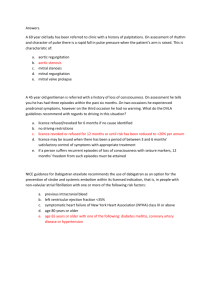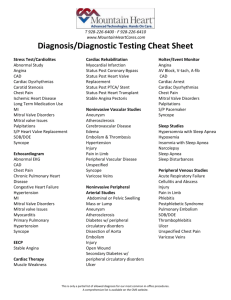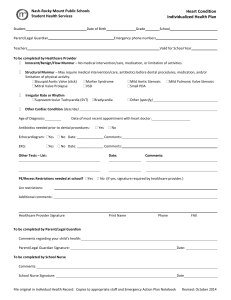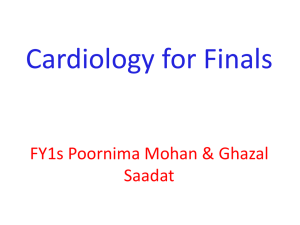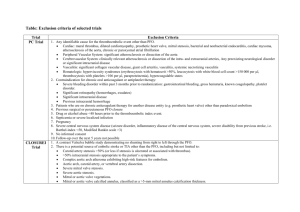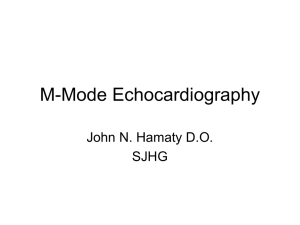5 ALTERED MYOCARDIAL TISSUE PERFUSION AND CARDIAC
advertisement
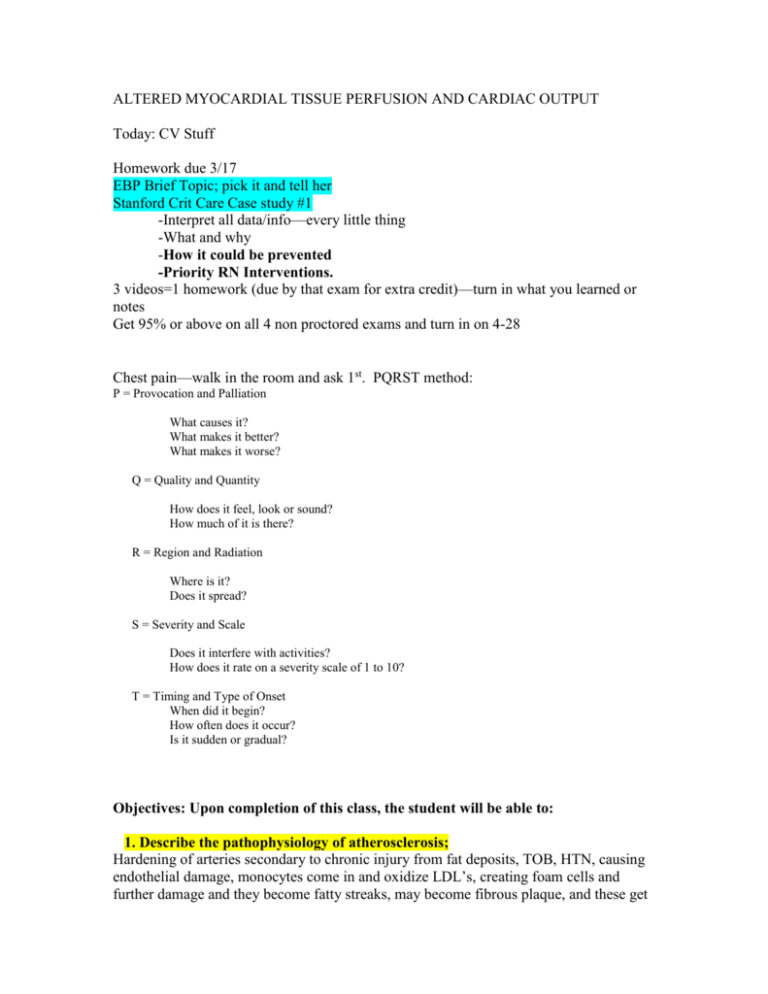
ALTERED MYOCARDIAL TISSUE PERFUSION AND CARDIAC OUTPUT Today: CV Stuff Homework due 3/17 EBP Brief Topic; pick it and tell her Stanford Crit Care Case study #1 -Interpret all data/info—every little thing -What and why -How it could be prevented -Priority RN Interventions. 3 videos=1 homework (due by that exam for extra credit)—turn in what you learned or notes Get 95% or above on all 4 non proctored exams and turn in on 4-28 Chest pain—walk in the room and ask 1st. PQRST method: P = Provocation and Palliation What causes it? What makes it better? What makes it worse? Q = Quality and Quantity How does it feel, look or sound? How much of it is there? R = Region and Radiation Where is it? Does it spread? S = Severity and Scale Does it interfere with activities? How does it rate on a severity scale of 1 to 10? T = Timing and Type of Onset When did it begin? How often does it occur? Is it sudden or gradual? Objectives: Upon completion of this class, the student will be able to: 1. Describe the pathophysiology of atherosclerosis; Hardening of arteries secondary to chronic injury from fat deposits, TOB, HTN, causing endothelial damage, monocytes come in and oxidize LDL’s, creating foam cells and further damage and they become fatty streaks, may become fibrous plaque, and these get big and ugly and they occlude the blood vessels. Lecture: “Causes endothelial damage— creates foam cells, macrophages, platelets jump on to form a thrombus [that is what finally causes your occusion]. Atherosclerosis likes to hit the hearteries and brain arteries.” LDL is bad, HDL is good. Serum cholesterol levels; total should be under 200. LDL should be 100-129, or less! Statins work by increasing the work of the LDL receptors in the liver. 2. Identify subjective data associated with CAD/Angina; Ask them the PQRST questions about chest pain. dyspnea, dizziness, chest pain, confusion. Sometimes chest pain doesn’t show up in women and old people. Old people more likely to get dyspnea, dizziness, confusion. Women, DM, elderly, may not have pain but have jaw, neck, or arm or stomach pain. Fatigue, nausea or exertional dyspnea. Objective: cyanosis, hypoxia, peripheral circulation [temp, color, pulses, edema]. Often comes w/ L ventricular dysfunction and PVD. Murmurs, rubs, gallops, weird rates and rythyms, abdominal bruits. Classic symptom is angina pectoris. 3. Define ACS, angina, and MI in terms of pathology, assessment, and management; ACS: Acute Coronary syndromes; and umbrella for all these occlusion/perfusion problems and their injuries. Any kind of educed blood blow, ischemia, leads to angina. Thrombi that occlude arteries. These are the diagnostic criteria: think about it like baby bear, mama bear, and papa bear. Pts w/ EKG changes suggesting ischemia but w/o bad blood tests [you get dx of unstable angina] Pts w/ ischemic ST segment EKG changes (ST depression or inverse T waves) AND positive blood labs [you are NSTEMI] Pts w/ ST elevation AND cardiac markers have STEMI Angina: Stable angina: chest pain that stops with rest or NTG. UA: unstable angina occurs randomly without exertion Prinzmetals/variant: occurs at night and unpredictable 4. Describe cardiac valve dysfunction in terms of types, assessment, and management; Mitral stenosis: from rheumatic heart disease/ fever, more common in women. CO decreases w/ moderate to severe MS. LA pressure increases, and then increases PA pressure, causing the R heart to fail. LV diastolic BP increases b/c of higher pressure gradient across valve. Aortic valve stenosis: from congenital or acquired narrowing of valve. Makes it hard to get blood out of L heart and to body. LV end diastolic pressures increases from back up. Valvular regurgitation: incompetent valves allow backflow during systole. Mitral Regurgitation: blood backflows into LA. Mitral valve prolapse: means your flap is flopping: MEGA regurgitation. This causes L vent hypertrophy b/c the poor thing has to work so hard. Assessmt: early sign of valve d/o is dyspnea w/ exertion. Dizziness, SOB, tachypnea, CSM, VS, hypotension and tach means decr CO, heart sounds, a fib, electrolytes. SOB chest pain, sweating, fainting. Mitral stenosis: jugular vein distension, hemoptysis, orthopnea, cough, afib Aortic stenosis: angina, syncope, systolic murmur Tricuspid stenosis: artrial dysrythmias, diastolic murmur, decr CO Pulmonic stenosis: cyanosis, systolic murmur Management: percutaneous ballon valvulplasty to open stenotic valves. Surgial valve repair, chordea tendinea reconstruction, prosthetics. 5. Define heart failure in terms of pathology, assessment, and management; Risk factors: High cholesterol, HTN, DM, CAD, valve problems, PVD, cardiotoxic agents [chemo], drugs, HF causes ventricular remodeling and then hypertrophy from stretching out and it never goes back into shape again. L HF: inadequate tissue perfusion From: HTN, CAD, MI, angina, Valve d/o Diastolic HF: ventricular, poor filling. Inadequate relaxation or “stiffening” prevents vent filling. Systolic HF: ventricular, low ejection fraction resulting in pulmonary and systemic conhestion R HF: systemic venous back up: from L HF, R MI, COPD or ARDs. Management: betablockers, DIG, ace inhibitors, ARBs if not ACE, diuretics [lasix]. Diuretics for preload Ace inhibitors & betablockers or ARBS for afterload Inotropes [dig] for contractility Lab Test: BNP; ventricular natriuretic peptide. Normal is below 100. Sever HF shows BNP 900+ Assmt: S3 is indicator of L HF. 6. Define HTN in terms of pathology, assessment, and management. Case Scenarios 1. You are caring for a 66 yo male admitted with chest pain, R/O MI. What is done initially to assess and manage his pain? Plus etoh, dm2, htn, tob, fam hx MI, obese Why do we always r/o MI first? Cuz they are big and bad Assmt: p 312 Pain: location, quality, how long, precipitating event (see PQRST) 12-lead EKG on them w/in 10 mins: 12-lead tell us if there’s damage: looking for an ST elevation. V1 may show a tiny little Q waves. Do continuous EKG monitoring. Blood tests: CK, troponin, or CKMB, tox screen How do we r/o MI? troponin blood sample; it’s part of cardiac muscle fiber and its released when cardiac tissue is damaged [should be less than 0.04], measured Q8x3—can also increase w/ CHF. CK lab: creatinine kinase greater than 5%—can be from brain, muscle, or cardiac tissue. There’s the CK-MB [what does MB stand for? Creatine Kinase-Myocardial Band] test that is cardiac specific. Also get a drug tox screen in case pt is on cocaine: coke can cause MI in avg healthy peeps or already-sick peeps. QuickTime™ and a decompressor are needed to see this picture. Do vitals: how often? Chest pain—walk in the room and ask 1st. PQRST method: P = Provocation and Palliation What causes it? What makes it better? What makes it worse? Q = Quality and Quantity How does it feel, look or sound? How much of it is there? R = Region and Radiation Where is it? Does it spread? S = Severity and Scale Does it interfere with activities? How does it rate on a severity scale of 1 to 10? T = Timing and Type of Onset When did it begin? How often does it occur? Is it sudden or gradual? STEMI: endo, ST elevation MI’s. NSTEMI: subendo [better to have, not full thickness of muscle, but still @ risk for another. Might not need cath lab. Sometimes no ekg changes, but we send them to cath anyway to dx.] Rx: MONA: morph, o2, nitro, aspirin. Beta- blockers [decr WOH and o2 demands] rests the myocardium. Be calm, let pt rest, relieve anx Lovenox—depends if they are hitting the cath lab right away. If an MD wont get you the order out of the MD, SBAR again and give more data. Go to the charge nurse if you have to—yes, people in authority get shit done that you can’t. Ichscemia: can have inverse T waves or ST depression. CAD: Plaque—coronaries Leads to atherosclerosis Causes endothelial damage—creates foam cells, macrophages, platelets jump on to form a thrombus [that is what finally causes your occusion] Atherosclerosis likes to hit the hearteries and brain arteries. What will kill this guy? If total occlusion, he gets really bad ischemia, leads to INFACRT, necrosis—for how long? No O2 for… -Ischemia is reversible -Infarct is lack of O2…too long. Vfib: usually caused by an MI. You have to defib these people stat b/c their heart tissues will not tolerate VF for long. VF is the best b/c we can shock you out of it—asystole is hard get back. Who drops dead from MI w/o all this plaque? Throwing a big ol clot, vasospastic angina. Our job is to prevent ischemia before it becomes infarct. TPA: stroke window is w/in 3 hrs. For an MI is it less?? Cath lab: new thing is to send them there, they visualize the clot and stent or ballon angioplasty. Or you might get a CABG. You can’t have a cathlab w/o access to CABG b/c you can bust an artery during cath and then you need an emergent CABG. Women don’t feel MI the same way, they need to know to take indigestion seriously. 2. He is positive for an MI. How do you know? What interventions are appropriate for him? 3. You are caring for a 78 yo female admitted with pulmonary edema, heart failure, and critical aortic stenosis. What assessment findings would you expect to find on admission? What management is indicated? Assess: Low perf, low BP, crackes, low SaO2, high HR. Check her K+. You do: o2, adj per Sa O2. IVF of LR or something not salty, run it low and slow. Dobutamine drip—dig takes too long. Morphine is a nice bronchodilator and pain med. Might give lasix to get fluid out of her lungs. Might need a PA or a vent. Family: tell her what’s the problem, what we’re doing, would you like to come in? Ask about DNR status [MD should do this]. You are caring for an African American male admitted with severe headaches, hx of HTN. His BP in ED is 220/118, HR 114. What medication is indicated initially? Nipride. Why HR up? His heart is pushing against all the BP. Pain mgmt What longterm management is indicated? Diet cons, HTN meds, education What patient education is indicated? How do you involve his family in the education? Risk factors for Stroke, MI, athero, CAD, HTN, etc Modifiable: Fat/Cholesterol Fatty diet Exercise TOB Stress Recreational use of stimulants Excess ETOH DM 1 or 2 that are poorly managed Unmanaged HTN [causes injury to endothelium, high afterload, work of Heart] While in hosp is great time to teach the modifiable stuff Non-modifiable Genetics Advanced age Afro American Male How can you help these people: don’t preach, be respectful/non-judgmental. Ask them what’s reasonable, give them choices, start w/ what they know. Ask what they want to do [lose weight], what their plan is. Don’t get their wife on your team. When they order a crappy hosp breakfast, give them alternatives from the menu. ATHEROSCLEROSIS B. Pathology: C. Risk Factors: 1. nonmodifiable: what are they? 2. modifiable: what are they? D. Collaborative Management: what is it? II. MYOCARDIAL TISSUE PERFUSION A. Coronary artery anatomy B. Impaired myocardial tissue perfusion 1. subjective data: angina: what are the types? 2. objective data; Physical assessment C. Assessment 1. ECG: what abnormalities? 2. cardiac markers: what are they? 3. exercise stress test 4. echocardiography III. ACUTE CORONARY PERFUSION IMPAIRMENT A. Dx of ACS: B. Nursing Diagnoses C. Collaborative management: what is done first? D. Interventions to restore myocardial tissue 1. perfusion a. thrombolytic therapy b. PCI c. CABG IV. VALVULAR HEART DISEASE Valves are: AV valves: Mitral in L heart Tricuspid in R heart Pulmonic- R Atrial-L S1: dub is the AV valves closing S2: lub is the other guys A. Valve Stenosis 1. def: 2. mitral valve stenosis Critical mitral stenosis: bad bad narrowing of the mitral, meaning blood can’t get from LA to LV. So blood goes back to the lungs—pulm edema and decr L CO. Poor perfusion to tissues, low BP, low LOC. Heart sounds like ‘swish-dub’. Where do we listen for that? All pimps take money: Aortic, pulmonic, tricusp, mitral. All pimps are on the 3rd ribs, sternal border. The other guys are 2 ribs down. Murmur is no extra sound, it’s a funky S1 or S2. S3 and S4: abnormal, from HTN, CHF, etc 3. aortic valve stenosis B. Valve Regurgitation 1. def: 2. mitral valve regurgitation 3. aortic valve regurgitation C. Infective Endocarditis D. Assessment and diagnosis E. Collaborative management V. HEART FAILURE Margi wants to focus more on this A. Def: Poor pump. Pulm edema will kill you—not ankle edema. Poor pumppoor COPoor perfusionlow renal perf RAA starts saves fluid and inc HTN inc venous returnmore stain on the heart. B. Conditions that trigger HF: know these! HTN, valvular disease, MI. Need to manage well to keep them out of Hosp. Nursing approach is making a big diff w these pts. C. Assessment and diagnosis 1. multisystem effects: know these! 2. prominent symptoms: what is life threatening? D. Collaborative Management Diuretics forever, dig, ACE inhibitors: less vasoconstriction, Aldosterone. Non pharm: daily wt, fluid restriction, relaxation, low salt diet E. Nursing Management F. Cardiomyopathy: end-stage HF Enlargement of the heart muscle to cope, frank starling law where it can’t go back again. VI. HYPERTENSION Def: systolic BP over 140 or DBP over 90, but they keep changing it. Basically keep it less than 130. No 1 reason for HTN just risk factors A. Risk Factors: know these! Obesity Atherosclerosis TOB Cushings Renal d/o Brain tumors SNS stress reponse: pain etc B. Assessment and diagnosis If HTN in my pt, ask: what’s his healthy normal at home, what was last BP, is he on meds, is he getting worse or better C. Collaborative management 8 kind anti-htn meds. ARB, Ca blockers, ACE prils, beta blockers, etc etc. Know these D. Nursing management

